| Designation: | 2S31 Vena |
 |
|---|---|---|
| Manufacturer: | Motovilikha Plants Corporation | |
| Product type: | Armoured Vehicles | |
| Name: | Self-propelled gun |
The gun represents the sheathed floating installation on a full-track landing gear. It is equipped: By the automated management system of prompting(guidance) in vertical and horizontal planes including computer for calculation of the installations for fire, By system automatic topometric and orientation, By system of day time / night optical-electronic reconnaissance and target destination for maintenance of high-precision fire. Means of detection of a laser radiation Means of statement of aerosolic protective veils.
The instrument(gun) differs by power of a common projectile for the purpose comparable to operation 152-155-mm of common projectiles, and pin-point accuracy of a combat. The machine has a sheathed body and sheathed rotated turret of a closed type from steel rolled sheets. 2C31 has the combined mortar installation, which one can deliver fire by all types of 120-mm of mines of domestic and foreign production, including with a laser guidance, and also special 120-mms by shells of different assignment.
Development, production 120-mm is created by the automated automotive gun 2N31 "Vena" in 1996. The automotive instrument(gun) is designed on the basis of clusters and aggregates BMP-1 and BMP-2.
In early 1997 Russia finally revealed the 120 mm 2S31 Vena self-propelled gun/mortar system which had been under development for some years.
Early development examples of the 2S31 were based on the Obiekt 934 light tank chassis developed by the Volgograd Tractor Plant but the first complete system, shown for the first time in the Middle East, is based on a much modified BMP-3 Infantry Fighting Vehicle (IFV) chassis.
The BMP-3 IFV entered service with the Russian Army in 1990 and is also being used for an increasing number of more specialised supporting roles of which the 2S31 is the latest.
While the prime contractor for the BMP-3 chassis is the Kurgan Machine Construction Plant, the prime contractor for the 2S31 Vena system is the Motovilikha Plants Corporation based in Perm which is involved in a number of other Russian artillery systems as well as multiple launch rocket systems.
Development of the 120 mm 2S31 Vena self-propelled gun/mortar system is complete.
The 120 mm 2S31 Vena system has been offered on the export market but as of late 2007 there are no exports of the system.
For the 2S31 application, the chassis of the BMP-3 IFV has been modified in a number of areas. The crew position either side of the driver has been removed as have the two bow-mounted forward-firing 7.62 mm PKT machine guns.
The existing two-person turret has been removed and replaced by a much larger turret with vertical sides and rear and a curved front. The hull rear of the vehicle has been modified and all roof hatches and rear doors have been removed.
A new and much smaller downward-opening hatch is provided in the rear of the hull on the left side. There are two ammunition resupply hatches in the right side, one in the hull and one in the turret.
The 2S31 Vena has a four-man crew consisting of driver seated at the front in the centre, commander in the turret on the right, gunner in the turret on the left and the ammunition loader who sits to the rear of the commander when travelling.
Turret traverse is powered through a full 360° with weapon elevation from -4 to +80°, manual controls are provided for emergency use.
Each vehicle is also fitted with an onboard automatic survey and orientation system. The advanced fire-control system includes a computer that calculates the information required to lay the 120 mm main armament onto the target and ensure a high first-round hit probability. The commander's cupola is mounted on the right side of the turret roof and has a large electro-optical sensor package on the right side, which is covered by a door when not required. This cupola can be traversed through a 90° arc.
This sensor package includes 1P51 day/image intensification sights and a 1D22S laser range-finder/designator with some components believed to be used in the BMP-3K reconnaissance vehicle. A 7.62 mm PKT machine gun is mounted on top of the cupola which can be laid and fired under complete armour protection and can be used to engage ground and air targets. The gunner has both direct and indirect fire sights.
The 2S31 Vena is fitted with a bank of six 81 mm electrically operated smoke/decoy grenade dischargers either side of the turret.
A laser detector is mounted on the low part of the turret front, either side of the 120 mm 2A80 ordnance and on either side of the turret roof at the rear which is used in conjunction with the smoke/decoy grenade system.
The long 120 mm 2A80 barrel is rifled and like other Russian 120 mm systems is not fitted with a fume extractor or a muzzle brake as it is of the low pressure type. The 120 mm ordnance is fitted with a combined breech mechanism, pneumatic rammer and a bore scavenging system.
This weapon has a direct and indirect fire capability and fires a new family of 120 mm ammunition. It can also fire the same family of ammunition as the current 120 mm 2S9 (tracked) and 2S23 (8 × 8) self-propelled gun mortar systems. According to Russian sources the high-explosive projectile has the equivalent destructive power of a 122 mm/152 mm artillery projectile.
The Russian BAZALT State Research and Production Enterprise has developed two new 120 mm projectiles for the 2S31 Vena self-propelled gun/mortar system, both of which weigh 26 kg.
The high-explosive fragmentation projectile has a minimum range of 2,000 m and a maximum range of 18,000 m with each projectile having a damage area of 2,200 m2.
The second is a cargo round which contains 35 high-explosive/fragmentation sub-munitions each of which will penetrate about 100 mm of conventional steel armour. These are designed to penetrate the vulnerable upper surfaces of armoured vehicles. This projectile has a minimum range of 1,500 m and a maximum range of 11,000 m. Each projectile has a damage area of about 10,000 m2 and the 2S31 Vena can also fire western natures of 120 mm rifled mortar ammunition.
More recently the Motovilikha Plants Corporation has stated that the maximum range when firing normal HE projectiles is 13,000 m and when firing 'mines' projectiles is 7,200 m.
A total of 70 120 mm projectiles is carried of which 22 (11 + 11) are in ready use magazines for rapid loading using a ramming system. Maximum rate of fire is quoted as 8 to 10 rds/min.
Also carried are 10 KBP Instrument Design Bureau 120 mm Kitolov-2M laser-guided projectiles which have a maximum range of 13 to 14 km with a 0.8 to 0.9 hit probability. Targets can be designated from the 2S31 Vena or from a normal tripod-mounted designator. The Kitolov-2M laser-guided projectiles are loaded manually.
The Kitolov was first revealed some time ago in 122 mm calibre for the 2S1 self-propelled artillery system.
Maximum quoted range for HE projectile is 13 km while for a standard mortar projectile it is 7.2 km.
The 2S31 has a combat weight of 19,500 kg and a power-to-weight ratio of 26.31 hp/tonne, maximum road speed is 70 km/h and cruising range on roads is 600 km. Other chassis details and specifications are almost identical to those of the BMP-3 which is covered in a separate entry.
Like other members of the BMP-3 family, Vena is fully amphibious being propelled in the water by two water-jets mounted low down one either side of the hull at the rear. Before entering the water the trim vane is erected at the front of the vehicle by the driver without leaving his seat and the bilge pumps are switched on.
Standard equipment for the 2S31 Vena includes an NBC system of the overpressure type, land navigation system, night vision equipment, vehicle washdown capability and a toilet.
Although the prototype of the 2S31 Vena is based on the chassis of the BMP-3 infantry combat vehicle, the turret system can be installed on a wide range of other chassis, tracked and wheeled.
|
||||||||||||||||||||||||||||
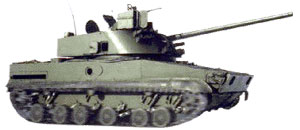 |
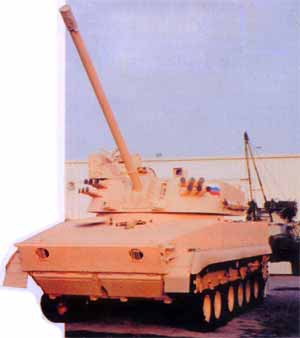 |
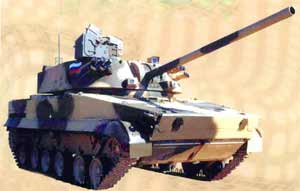 |
 |
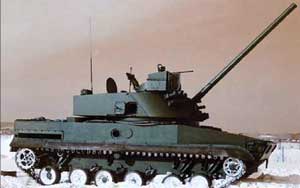 |
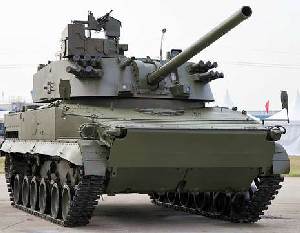 |
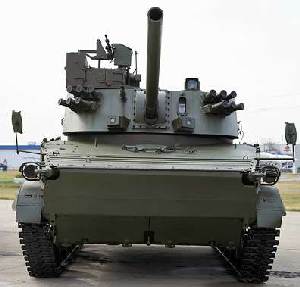 |
 |
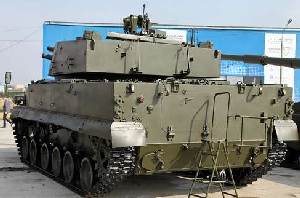 |
